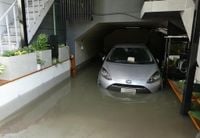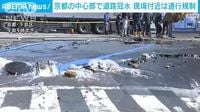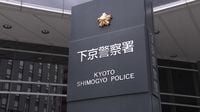On April 30, 2025, a significant flooding incident occurred on National Route 1 in Kyoto City, leading to widespread disruption and concern among local residents. The flooding, which began around 3:30 AM, was reportedly caused by a burst water pipe, believed to be a result of aging infrastructure.
The emergency unfolded near the Takanouchi intersection in Shimogyo Ward, where a passerby alerted authorities to the situation. Police confirmed that water was overflowing onto the road, which quickly spread to surrounding areas, affecting homes and businesses nearby.
According to the Kyoto City Waterworks Bureau, the damaged water pipe, measuring approximately 30 centimeters in diameter, was installed in 1959 and had been scheduled for replacement due to its deteriorating condition. The bureau indicated that the aging of the pipe was likely the cause of the rupture, which resulted in a significant volume of water gushing onto the roadway.
As the situation escalated, the Kyoto Prefectural Police implemented traffic regulations around 4:30 AM, closing off certain lanes on National Route 1 to facilitate emergency response efforts. This led to traffic congestion, with reports indicating that approximately 1.4 kilometers of backup formed on the westbound lane by 9:00 AM.
In addition to traffic disruptions, the flooding raised concerns about water quality in the area. Officials warned that around 6,500 homes might experience muddy water due to the contamination caused by the burst pipe. Public address vehicles were dispatched to warn residents, and emergency water supply trucks were sent to distribute clean drinking water.
Local residents expressed their shock and concern over the incident. One nearby resident described the moment he was awakened by the sound of rushing water, stating, "When I woke up, I heard a sound like rain. When I looked outside, the water was flowing like a river with tremendous force, and it had entered my house." Another resident, whose underground parking lot was flooded, described how the water reached the hood of his car, leaving him feeling hopeless about the vehicle's fate.
The flooding also impacted local businesses, particularly a nearby supermarket. The store manager reported that the water supply had become muddy, making it unusable for washing food. As a temporary solution, the supermarket began using bottled water and saw a surge in demand for bottled drinks, prompting them to place additional orders.
As of late morning, restoration efforts were underway, but no timeline for full recovery had been established. The Ministry of Land, Infrastructure, Transport and Tourism’s Kyoto National Highway Office took over management of the situation, coordinating with local authorities to address the ongoing issues.
This incident highlights the critical need for infrastructure upgrades in Kyoto, particularly as aging water pipes pose a risk to public safety and daily life. The city is now faced with the challenge of not only restoring normalcy but also ensuring that such incidents do not recur in the future.
As residents await the resolution of this crisis, the local government is under pressure to expedite repairs and improve the aging water infrastructure that has led to this alarming event. The community remains hopeful for a swift recovery and a return to normalcy.



